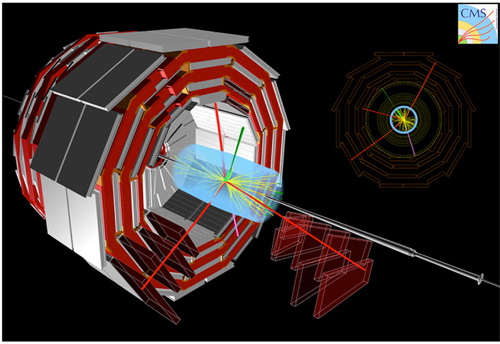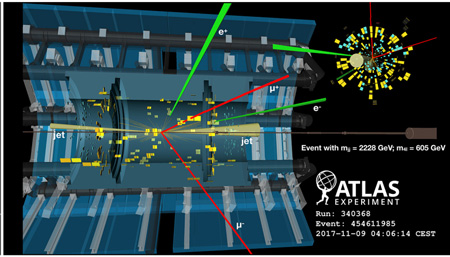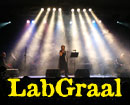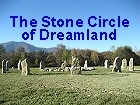| English Page |
Search for new physics through multiboson production |
 |
 |
| 24 June 2020 | ||||
The ATLAS and CMS experiments presented new results relating to a physics process called vector boson scattering
This media update is part of a series related to the 2020 Large Hadron Collider Physics conference, which took place from 25 to 30 May 2020. Originally planned to take place in Paris, the conference was held entirely online due to the COVID-19 pandemic. At the LHCP conference this year, the ATLAS and CMS collaborations presented new results relating to a physics process called vector boson scattering. CMS also reported the first observation of the so-called “massive triboson production”. Studying these processes to test the Standard Model is important as it could shed light on new physics. During proton collisions at the LHC, many particles, including the carriers of the electroweak force – photons and W and Z bosons – are produced. These bosons are often referred to simply as vector bosons, in the Standard Model, and one of the processes that leads to their pair production is called vector boson scattering. Vector boson processes are an excellent probe to seek deviation from theoretical predictions. Two rare processes that are of particular interest as they probe the self-interactions of four vector bosons are diboson production via vector boson scattering and triboson production. The observation and measurement of these processes are important as they test the electroweak symmetry breaking mechanism, whereby the unified electroweak force separates into electromagnetic and weak forces in the Standard Model, and are complementary to the measurements of Higgs boson production and decay. In a vector boson scattering process, a vector boson is radiated from a quark in each proton and these vector bosons scatter off one another to produce a diboson final state. Triboson production refers instead to the production of three massive vector bosons. At the LHCP conference, physicists from the ATLAS and CMS collaborations presented new searches for the production of a pair of Z bosons via electroweak production including the vector boson scattering mechanism. ATLAS observed this process at 5.5 sigma and CMS reported strong evidence. CMS also reported the first observation of a W boson produced in association with a photon through the vector boson scattering process, as well as more precise measurements of the same-sign WW production, and an observation of the vector boson scattering production of a W and a Z boson, complementing earlier ATLAS observations. Another way to probe four-boson interaction is to study the very rare production of three massive bosons or tribosons. This April, the CMS experiment released a 5.7 sigma result of the triboson phenomenon, establishing it as a firm observation, following the first evidence of this process seen by the ATLAS experiment last year. Most physics processes of fundamental particles involve two or more individual particles that interact with each other via an intermediary particle that is emitted or absorbed in the process.
“The more bosons produced, the rarer the event. This new observation of tribosons was very difficult because it is a much rarer process than the one that led to the Higgs boson discovery, and very interesting because it may reveal signs of new particles and anomalous interactions,” says Roberto Carlin, CMS spokesperson. In the triboson and vector boson scattering processes, W and Z can interact with themselves to create more W and Z particles, producing two or three bosons. W and Z being highly unstable particles, they quickly decay into leptons (electrons, muons, taus and their corresponding neutrinos) or quarks. But such processes are extremely rare and the diboson and triboson events that physicists look for are mimicked by background processes, making them even more difficult for physicists to analyse. “To separate signal from background, physicists have to be ingenious and employ advanced machine learning algorithms. This is a challenging task for such rare processes, and requires meticulous and thorough studies,” says Karl Jakobs, ATLAS spokesperson. The measurements of vector boson scattering and triboson production presented at LHCP 2020 are consistent with the predictions made by the Standard Model, which remains our best understanding of fundamental particles and their interactions. The above observations also provide physicists with tools to probe quartic self-interaction between massive electroweak bosons. The current measurements place constraints on the strength at which these quartic interactions take place and increased precision from the use of new datasets could open up horizons for new physics at higher energy scales in the LHC and lead to possible discoveries of new particles. |
 -->
-->














